Roman Emperor Nero

Rising to power at age seventeen when his mother Agrippina supposedly poisoned her husband and Roman Emperor Claudius, after five years on the throne, Nero succumbed to repeated encouragements by Roman philosopher and confidant Seneca, to step away from his domineering mother’s shadow.
No Nepotism for Nero
When Agrippina caught wind of Nero’s pending emancipation, she promoted her stepson Britannicus as the true heir to the Roman throne, until Britannicus passed away under dubious circumstances in 59 A.D., followed by Agrippina’s own death when Nero sent an assassin to kill her in her villa.
Nero married Poppaea Sabina in 62 A.D., until he killed his young wife with a single kick to her belly, in what Roman historian Tacitus phrased as “a casual outburst of rage.”
After the murder of the women in his life, Nero threw himself into his passions for art and music, oftentimes singing and playing the lyre to his captive audiences, while encouraging the upper classes to take dance lessons.
Emperor Nero’s Olympic Games
He also ordered that athletic competitions be held in Rome every five years—the birth of the Olympics, which he himself trained and competed in—until on June 19th, 64 A.D., a fire broke out in the shops surrounding the Circus Maximus, destroying three of Rome’s 14 districts during a nine-day conflagration that severely damaged another seven before the flames were put down.
Eyewitness reports claimed that Nero was on the roof of his palace while Rome burned, singing a song from the Greek epic “The Sack of Ilium,” which sparked rumors that Nero himself had set Rome blaze in order to expand the scope his palace complex.
Reconstruction of Rome
During Nero’s bold reconstruction of Rome, the emperor deflected attention by blaming the fire on the first century Christians, torturing and killing many of them while his reconstruction efforts exhausted the Roman treasury.
By the end of Nero’s life, the Roman Empire was under severe financial stress, while revolts in Britain, Judea and Parthia steadily weakened his rule. When Nero caught wind of an assassination plot on his life in 65 A.D., he ordered the deaths of a prefect, several senators and several more military officers.
Dodging the heat with an extended tour of Greece, Nero returned home in 68 A.D., worsening his plight by poorly managing pockets of unrest in Africa, Spain and France.
How did Emperor Nero Die?
When the Senate declared Nero an enemy of the people, he committed suicide after his attempts to flee Rome had failed. Fifty years later, Roman historian Suetonius wrote of Nero’s final lament, “What an artist dies within me!”
